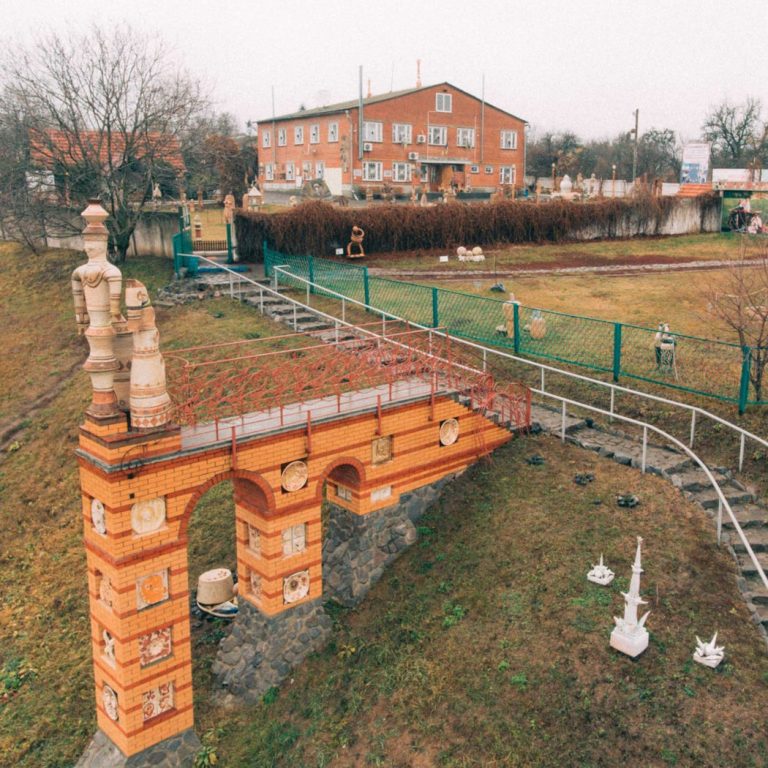There are about ten pottery centres in Ukraine. Opishne in the Poltava region is the largest among them. This is an old Cossack town (nowadays it has the status of the urban-type settlement – ed.), that is rich in the clay deposits. Here on the edge of the 19-20 centuries, every third family was engaged in pottery.
The National Museum of Ukrainian Pottery is located in Opishne – it is an exclusive institution where the Ukrainian pottery heritage is researched, preserved and popularised. There are some contradictions in the name of the town: the signposts at the entrance to the town tells us “Opishnya”. Yet the locals call it Opishnye or Opishne. The director of the Museum Oles Poshyvailo told us about the story with the name, the pottery traditions of his family and the development of the pottery museum in Opishne:
— Opishne is the ethnographic name of the town. In fact, the first recorded name of it was Opochynske. It was the land of the Polish Prince Vyshnevetskyi. That is why on the first maps and cartographic plans the town of Opochynske appears. But even at that time, the locals called it Opishnye because it was the border settlement of the Hetmanate. Beyond this point there was an unpopulated, wild plain. In the Belarusian language “aposhni” means the bordering, the last. Perhaps this is where the name of the town originates from. There are documents of the second half of the 19th century, where this small town is mentioned. On the maps of the Russian Empire the Oposhnya is indicated, but this name is Russified, invented by the Russian clerks because it was difficult for them to pronounce “Opishne”. Therefore, in the 19th century the place name “Oposhnya” spread. We are trying to return to the old name and we are dreaming that once the Ukrainian Parliament will clarify this and the maps will show not Opishnya, but Opishne or Opishnye.
For the centuries people of Opishne were engaged in handicrafts, and the prominent place among these belonged to the pottery. At the end of the 19th century, the first local pottery school-workshop on the left bank part of Ukraine was established in the town. This way it was an attempt not only to preserve the pottery but also to modernise it, to make it competitive. Because at that time in the town Budy (Kharkiv region) the faience factory of Matviy Kuznetsov was already working. With the time passing the earthenware produced industrially became cheaper and more affordable.
This has become a major challenge for the traditional pottery. In order not to lose the position in the developing world potters were encouraged to create and decorate predominantly art ceramics. In the beginning of the 20th century the famous Ukrainian artists such as, for example, landscape painter Serhiy Vasylkivskyi, painter, architect and graphic artist Vasyl Krychevskyi, and also animal painter Mykola Samokysh were involved to this.
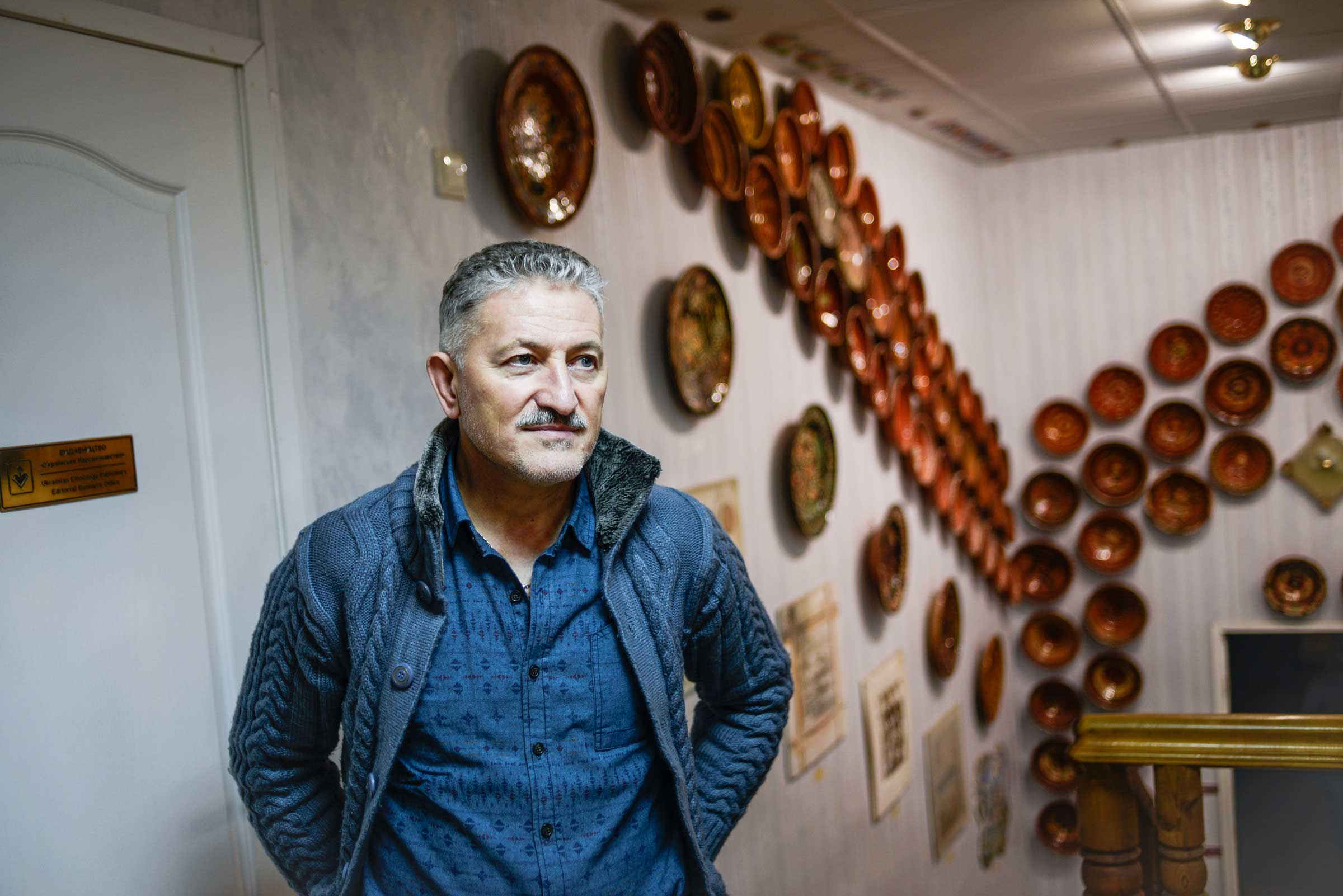
Oles Poshyvailo, founder and the director of the pottery museum
A new style of earthenware decoration with baroque ornamentation emerged in Opishne during this period. It pre-defined the look of Opishne ceramics for the whole century ahead and got it a worldwide recognition.
The development of the museum initiative and the first attempts to preserve the pottery heritage began in Opishne at the beginning of the last century, when the famous at that time pottery technologist Petro Vaulin had founded the first in Ukraine museum of old pottery. A few years later his collection was transferred to the Poltava Museum.
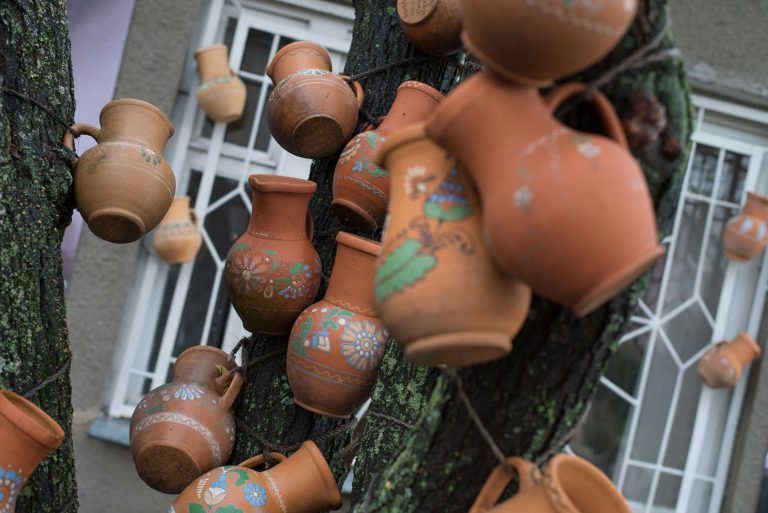
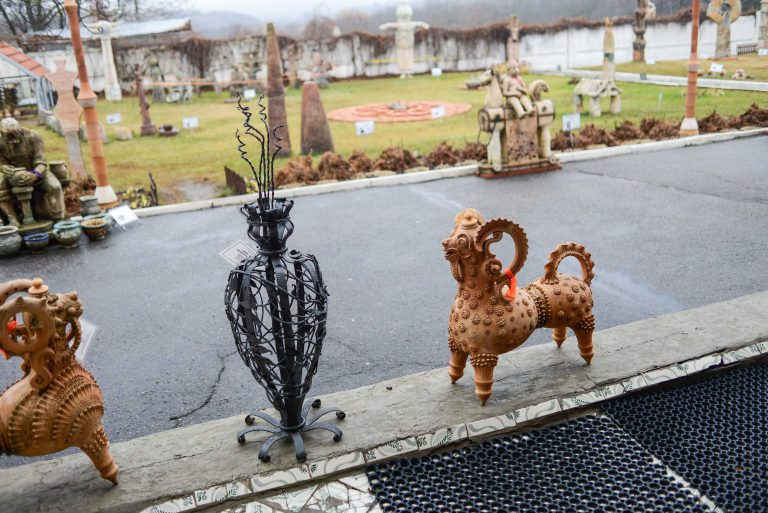
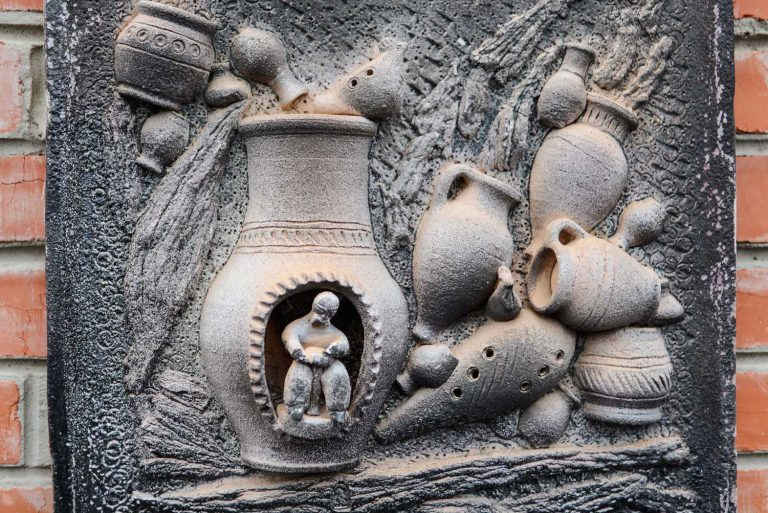
slideshow
In the early 1970’s Gavrylo and Yavdokha Poshyvailo established the first home museum of ceramics in their own home in Opishne. This family museum became the basis for the further development of the National Museum of Pottery by their grandson Oles.
Everyone interested could visit the Poshyvailos’ Museum to see the pottery, towels, tablecloths. Foreign delegations also visited it. The grandson of Yavdokha cannot recall any other similar initiative when the ordinary woman from a village would have created a museum:
— I do not know how my grandmother got this intention to create a museum. Probably it came from the love to the crafts per se, because she loved pottery above all.
The Pottery Museum
Initially, this was supposed to be only the museum of Opishne, which afterwards grew into the Museum of Pottery of Poltava region and, eventually, evolved into the national-level museum.
Oles Poshyvailo recalls that when in 1985 the local ceramics factory moved to another building this house was vacated, and the administration planned to use it as a dormitory for the workers:
— Then the Opishne craftsmen and I realised that if we do not save this house, which was one of the oldest in the village and was built by the project of Vasyl Krychevskyi, the pottery culture of Ukraine would loose it. This was how we initiated the creation of The Pottery Museum in Opishne.
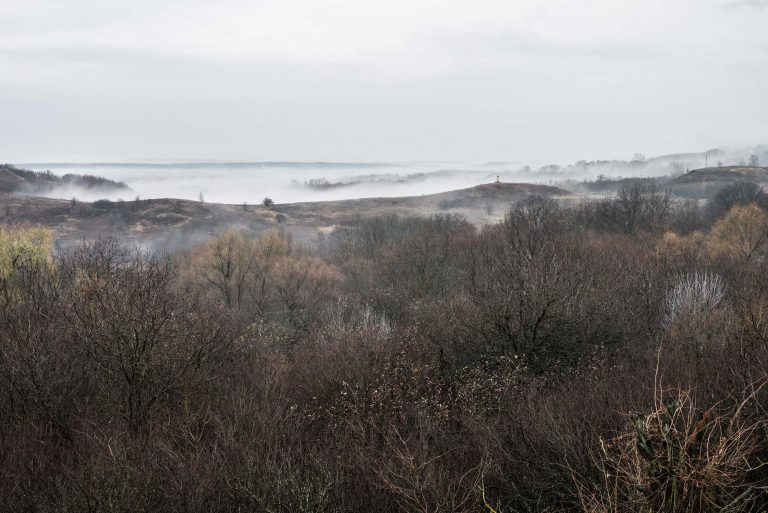
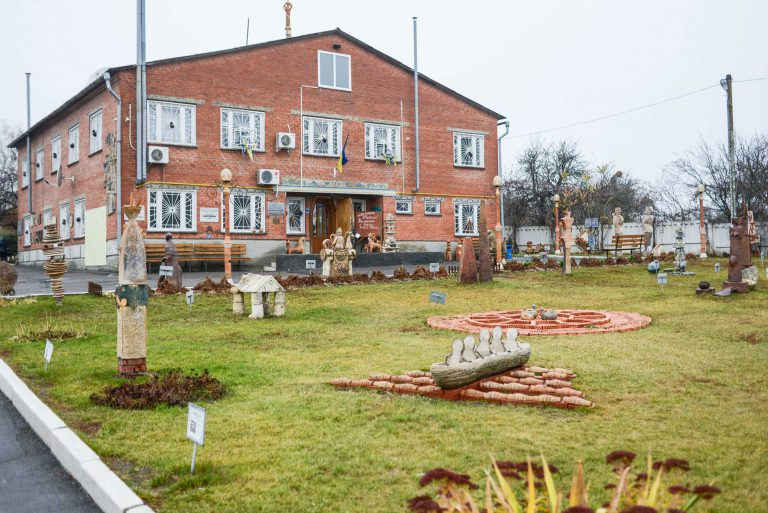
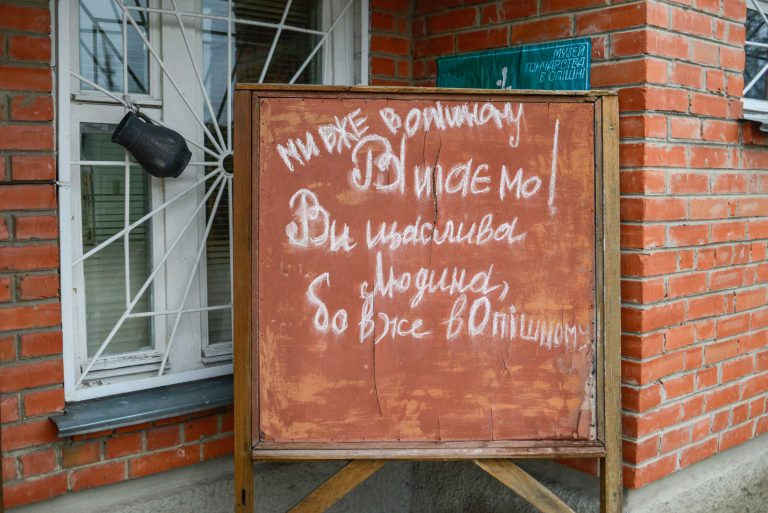
slideshow
Today the museum’s fund has more than 50 thousand items. This is the largest collection of the traditional pottery in Ukraine, but the visitors can see only around one percent of it. Oles tells us how the collection was formed:
— I brought the first exhibits from expeditions to the surrounding villages. But when there were no funds for the purchase of new exhibits we began to organise the symposiums of ceramic artists. We were inviting potters from all over the country. During the month they had been creating sculptures that were left here in the museum. So the park of monumental sculpture appeared here. Unlike the traditional museum showcases, visitors here can walk in a nature park and take pictures with sculptures.
Today the museum employs 108 full-time staff members and continues to expand, and it needs new specialists. But there is a decree of the Cabinet of Ministers of Ukraine prohibiting the increase in the number of employees of the budget institutions. This is artificially limiting the development of the cultural institutions.
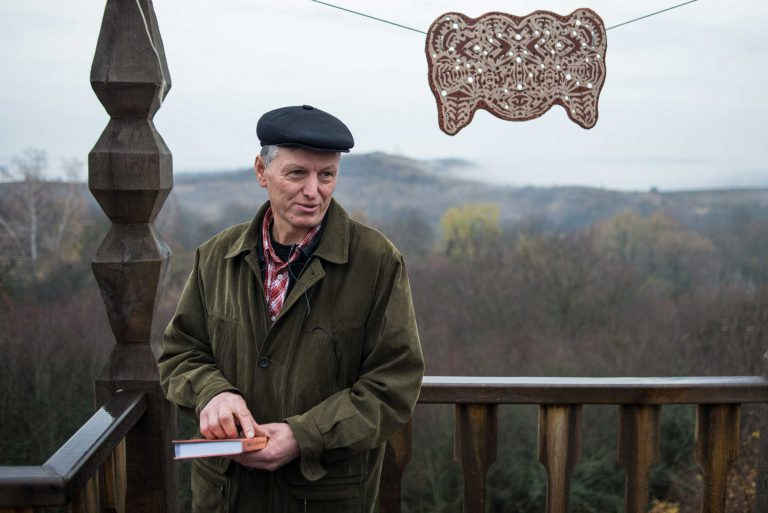
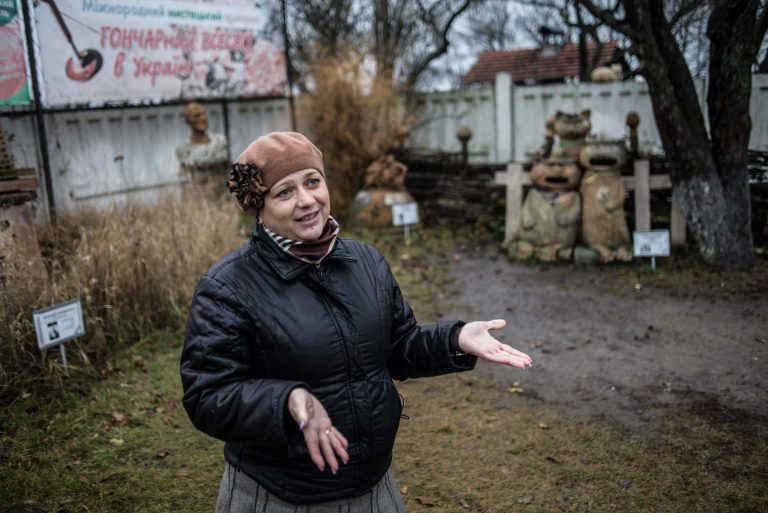
slideshow
— Such limitations become an incentive for us to find new survival methods, new methods of work. If there were not so many crises in Ukraine, we would not have built such a museum. Despite the crisis, we have doubled the number of visitors after the Revolution of Dignity, even though the cost of an entrance ticket for all our exhibitions is more than 50 UAH. Everything that is done in the museum today is financed exclusively from the money earned from the excursions. The developers of our museum are, in fact, Ukrainian residents who pay for the entrance ticket. The money we receive from the state we use only for employee salaries and the utilities.
According to Mr Oles, the team of the museum defines the directions of the institution development following the own vision:
— None of the state authorities to which we are subordinated – neither the district department nor the Ministry of Culture – is interfering in this process.
Potters Family the Poshyvailos
Thanks to his grandmother Yavdokha Mr.Oles had got the idea to found the museum and had experienced the museum business. He had become a researcher also because of his grandmother advice. Igor Poshivaylo, the cousin of Oles, had also got his PhD in History, and nowadays he works at the National Centre of Folk Culture “Ivan Honchar Museum”, named after the collector of its exposition, Ukrainian sculptor and ethnographer Ivan Honchar.
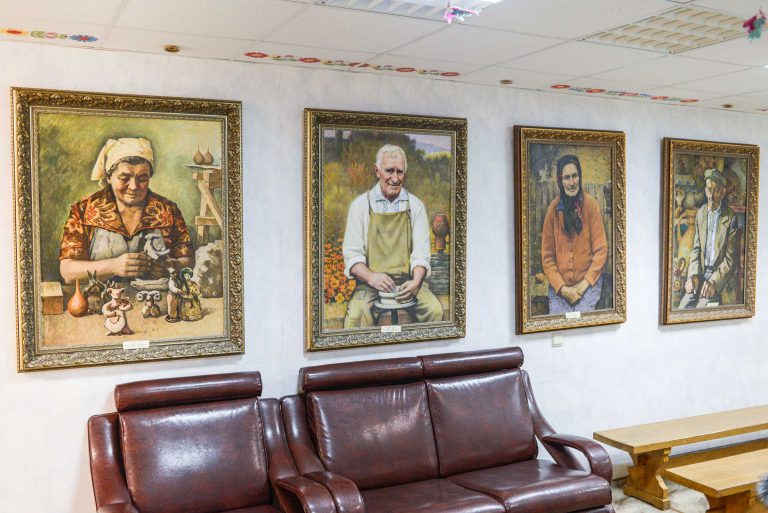
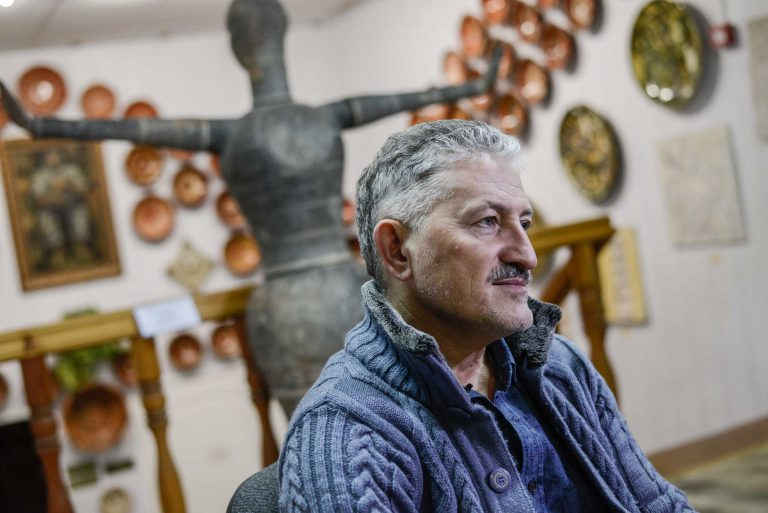
slideshow
The Poshyvailos family is engaged in pottery since the second half of the 18th century.
— My family is the oldest potters family that keeps working until nowadays. You will not find in the informational sources any surname of the potters that would be mentioned both in the 18th century and in the beginning of the 21st century. Very often the potter family lines were interrupted due to the social cataclysms. Especially during the repressions, famine periods the pottery tradition was disappearing. Now we are trying to foster the dynastic pottery traditions in Ukraine, and also to support the potters, to encourage their creativity, to make the potters family never ending.
Grandfather of Oles, Havrylo Poshyvailo, was born in Opishne in the family of the potter-earthenware makers Nychypor Poshyvailo and Hanna Poshyvailo. His grandfather Taras in the last quarter of the 19th century had been making glazed pottery, and his grandmother Kylyna – toys for kids.
Havrylo had been making earthenware, decorative sculptures, and toys. His wife Yavdokha was a talented potter painter, she had been decorating her husband’s works with floral and zoomorphic compositions. The main colours for decorating the ceramics, which were used in the past and remain actual nowadays, are red, green, black and dark blue.
Mykola Poshyvailo continues with the craft of his parents. A talented potter, and previously a creative artist at the “Art Ceramist” factory, 87-years-old man continues to work for pleasure and holds workshops for the visitors of the museum.
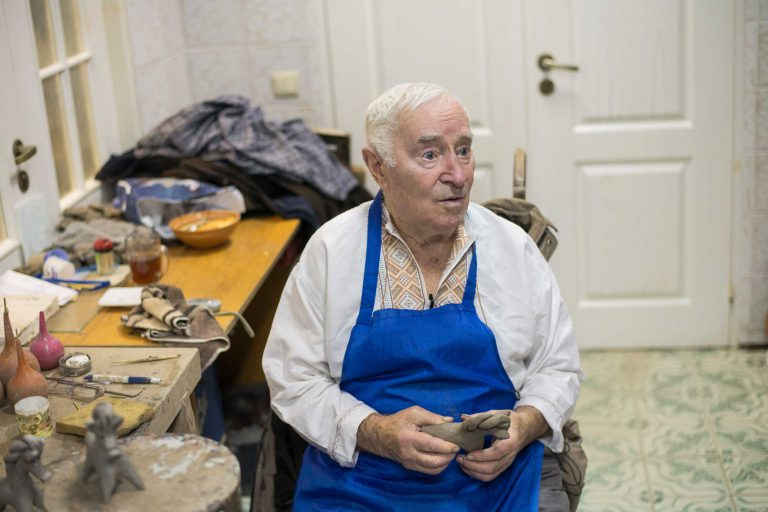
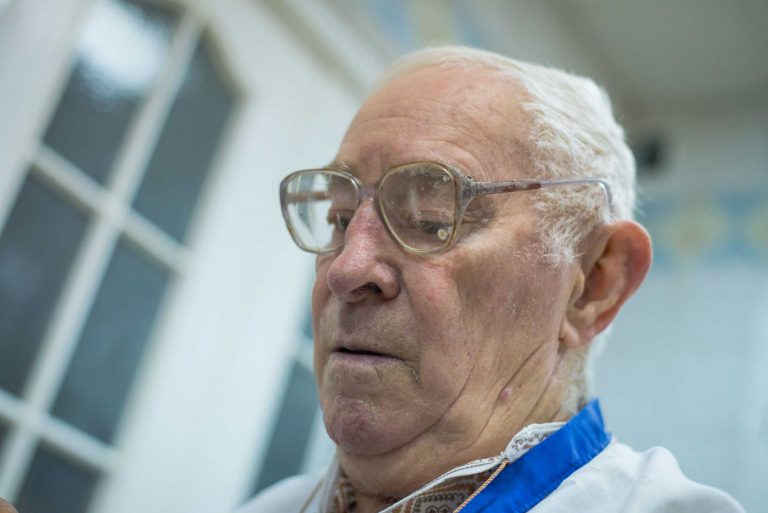
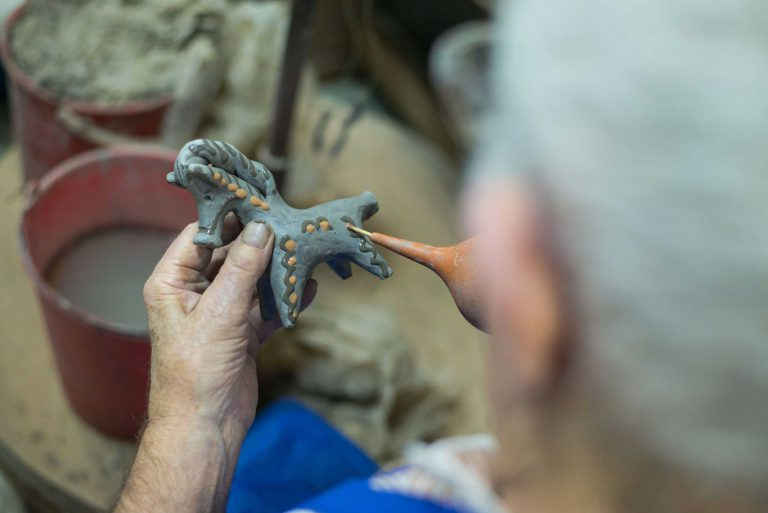
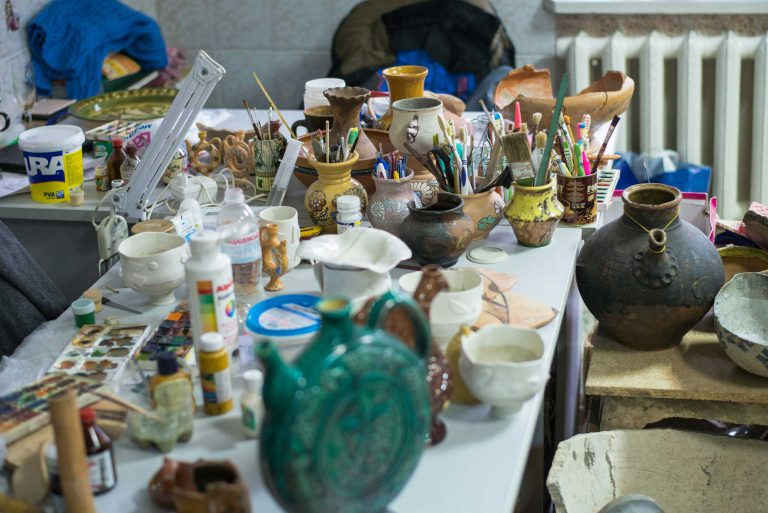
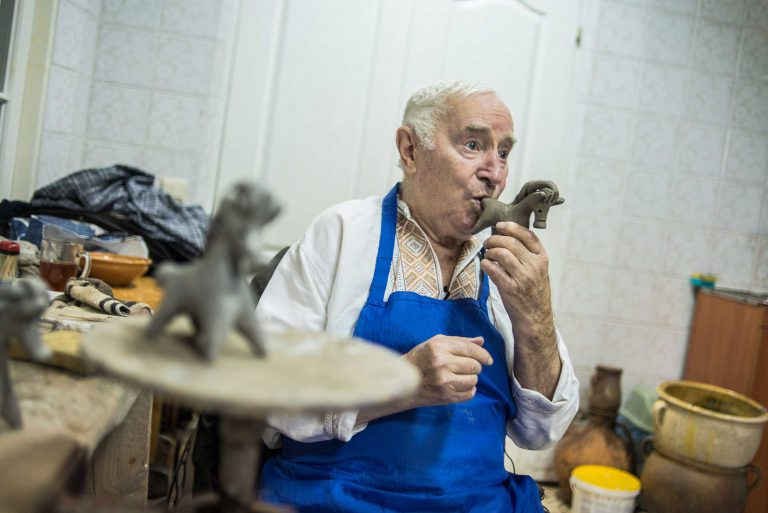
slideshow
Mr Mykola started pottering when he was 15 years old. He believes that to become a potter the support of the senior masters is important, especially at the beginning. He recalls that his parents were also helping to build a new museum:
— My mother said that I have to build a museum while she is still alive. We managed to build it when she was still with us, although not all the buildings.
In 1999, a memorial museum of the potter family Poshyvailos was opened as a separate unit of the National Museum of Ukrainian Pottery in Opishne. The museum houses the artworks of three generations of the potter family Poshyvailos and other masters of the 19th-20th centuries, traditional embroidery of the Poltava region, folk art and old icons. In 2016, the street on which the museum is located had been renamed after Havrylo and Yavdokha Poshyvailo.
Museum nowadays
Over the past 100 years, the number of potters in Ukraine has decreased and become ten times less. There are only about a dozen of the real masters who work with the pottery wheel in Opishne.
Previously the potters brought their products to fairs themselves; nowadays dealers do it instead of them. Because of that, as Oles Poshyvailo explains, the connection between the master and the customer is lost:
— This connection is extremely important, because when the potter went to the market he got to know the demand of the people and, accordingly, tried to satisfy it. The master did everything to make products good looking, with a beautiful pattern. This way an exquisite form of folk artworks from Opishne was developing during the centuries.
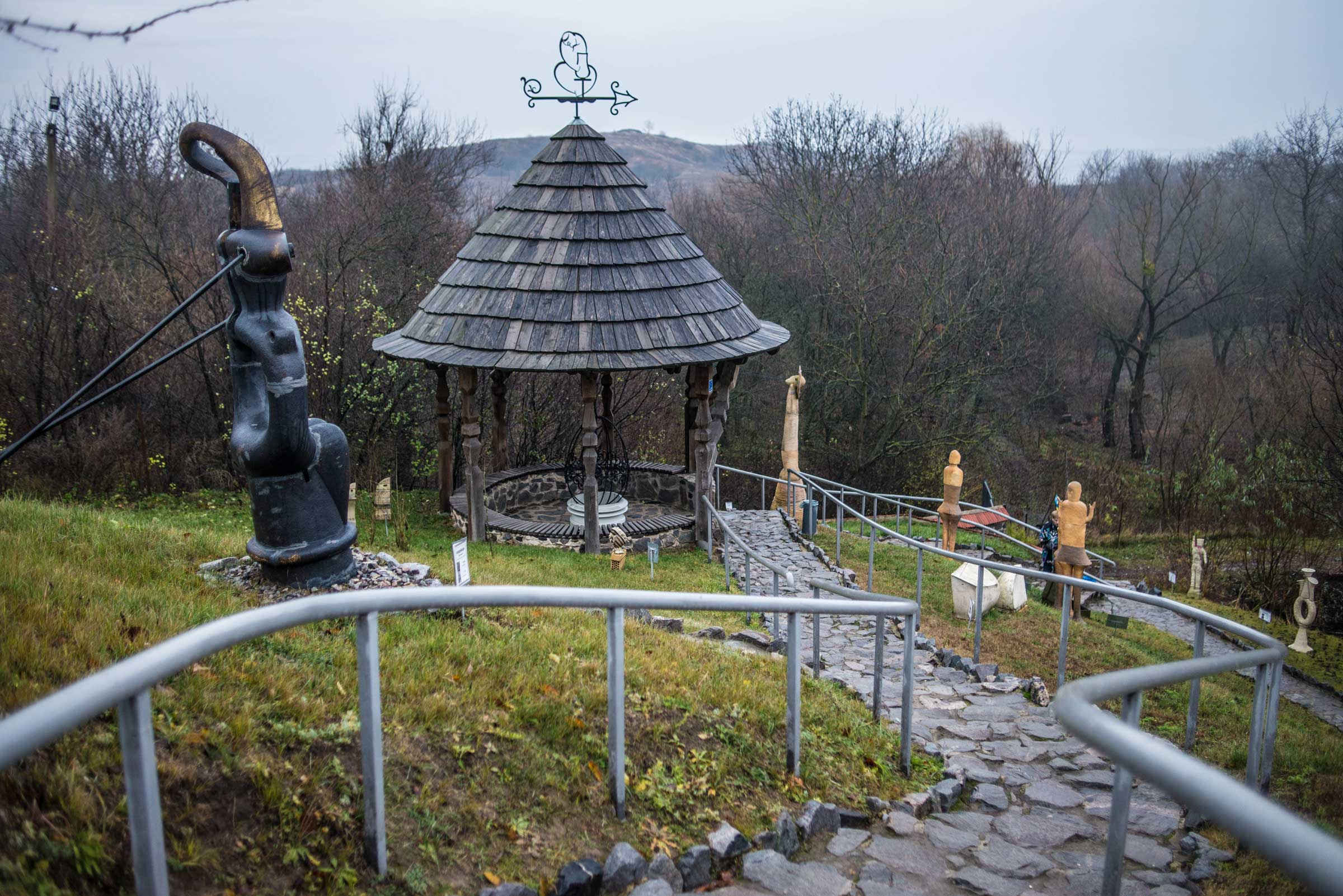
The pottery master classes are very popular in the museum. People participate because they have a desire to create something by themselves. In the feedback for the museum, they say it helps them to feel themselves the Ukrainians. This is actually the mission of such institutions:
— This is not a treasury of antiquities, but a living organism that forces us to rethink ourselves as part of our nation.
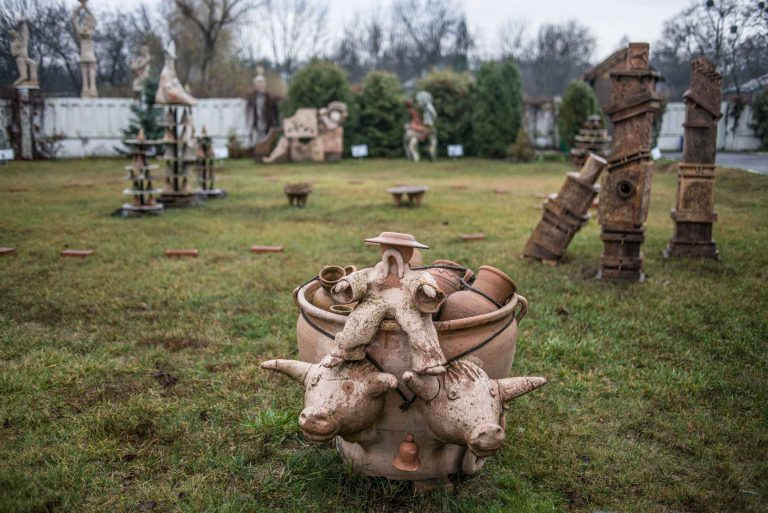
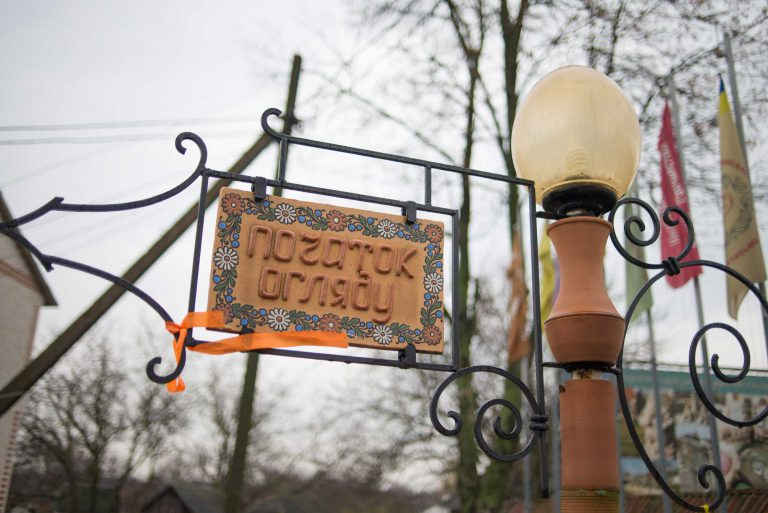
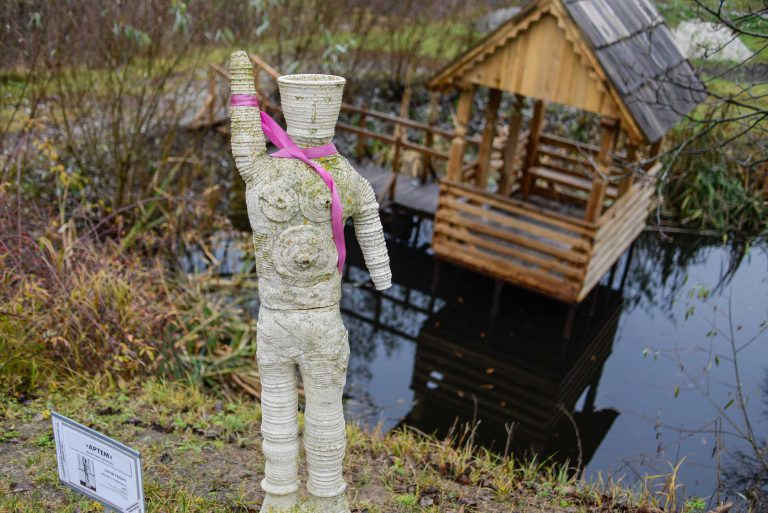
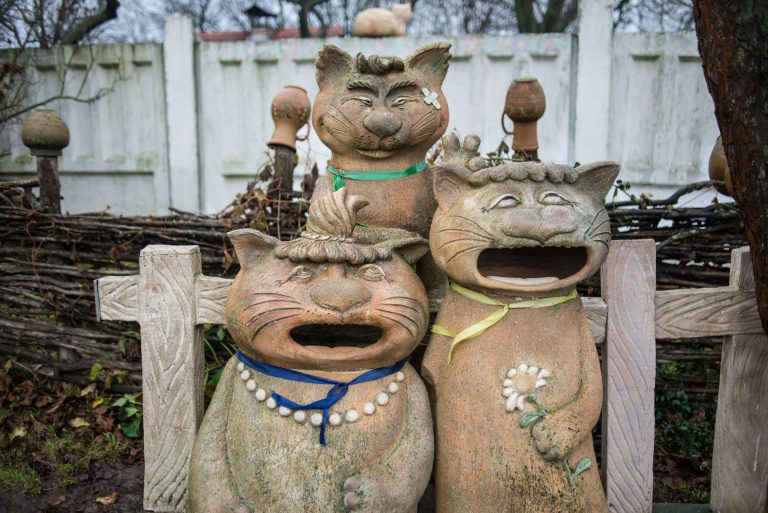
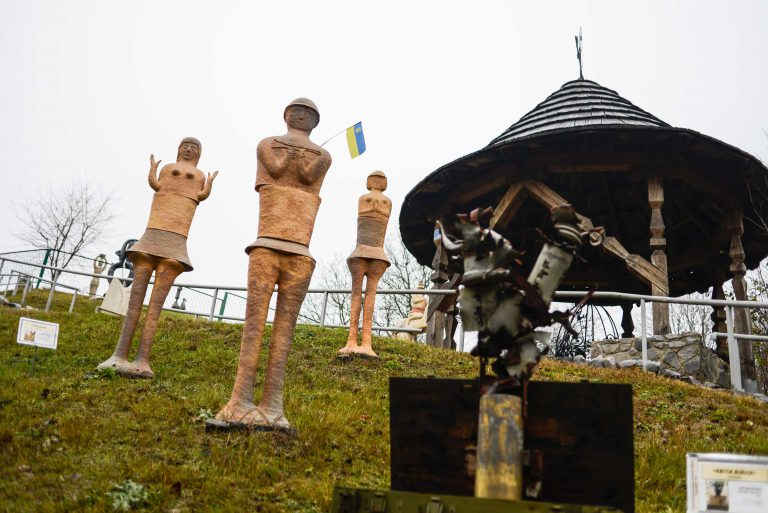
slideshow
— The museum not only had changed Opishne, but it still continues to do so. If there were no museum, then there would be no pottery here neither. It would disappear as it is disappearing in many other former centres of the pottery.
Tourism is developing quite actively here. Staryi Khutir town, for example, has become such a tourist attraction, there are now festivals taking place, there is a place to eat, a place to stay overnight. The other places appear also. However, our expedition visited Opishne in winter, so we could not fully observe the progress.
In the mid-1990s, Oles Poshyvailo tells us, the Ministry of Culture had developed a new strategy for the development of culture in Ukraine, and this had encouraged the innovative methods of work:
— At that time, we had been the only museum in Ukraine that had a local cultural centre, a library, a music school and a secondary school in its structure. Based on the secondary school a specialised school was created, there the children learned pottery starting from the 1st year. All this existed until 2003.
Today, the museum continues to grow and develop. Annually the potter symposiums, conferences, festival and residences for artists are held here:
— We bought a house from the year 1902, there was a potter living here next to the museum. We plan to make a residence for ceramic artists there. The residence, in fact, has been operating here for 4 years already, but in the different premises. We invite artists and having everything needed they work for several months, create their own artworks there. They work under the condition that they can take half of their artworks, and leave the other half for the museum.
About the shooting process
Check out our video blog for the adventures of the team in the Poltavshchyna expedition and, in particular, on their road to Opishne:

